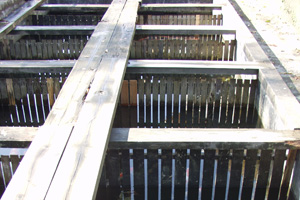The vast majority of able-bodied men from all parts of Japan were conscripted to fight for Japan to the death – and many did until Hiroshima and Nagasaki were dealt the final blows and Japan surrendered.
The soldiers who returned to their mountain villages to commence farming again after 1945 could not have possibly expected their coloured carp to have survived the past five years or so of grueling winters without the necessary and vital care involved. Instead they soon discovered that most had died and the villagers who were desperate for food and without money or means to purchase this readily ate the carcasses.
After 1945 the method of food carp production was continued and improved upon right up to around 1950 whereby carp fry were still grown from eggs in ‘canals’ mentioned earlier which irrigated the then circular rice paddies. These canals were usually 60cms wide and 45cms deep and had no form of aeration at all, as a result dissolved oxygen content of the water was seriously depleted during high summer. Many young carp were taken by birds, cats and raccoons especially as the fry grew to become more easily visible.
During this short five year period coloured carp production re-started in earnest with a few parents that had managed to be secretly protected against the ravages of war.
As mentioned earlier, in 1947 the Izumiya farm began to trade, albeit in a very small way, in both carp for the table and coloured versions to be kept as pets.
From 1950 the hitherto inaccessible mountainsides were terraced by machine and new, rectangular rice paddies were excavated to replace the circular ones. The ‘tamed’ mountains now became new and valuable areas for farming rice whilst the flatter, surrounding areas could then instead be used for more valuable industrial and domestic dwelling purposes.
Now, instead of each paddy being irrigated by its own canal, large reservoirs were excavated at the top of each mountain and were used, as and when required, to irrigate the paddies below. Many carp food farmers used these reservoirs to grow their fry for the summer after the canals started to disappear.
In 2000, Toshikatsu Igarashi from the Marusada Koi farm in Mushigame told me that there were no purpose-made mud ponds at all for coloured carp in Yamakoshi even as recently as 1950 and the mountain top reservoirs were all completely reserved in growing Magoi for food – a far more valuable commodity at the time.
Now we move on to the important part in the development of ‘coloured carp’.
By 1955 the annual production of salted Magoi for food exceeded the demand for this in Yamakoshi – even by extra demand from the rapidly expanding communities in adjacent areas. As a result the producers had to find other areas in Japan where their surplus production could be sold for money rather than having to be wastefully destroyed.
As a result ‘wet-fish’ wholesale companies were contacted in all other areas of Japan advertising the availability of delicious, salted baby carp for sale direct from the producers in Niigata.
Thus followed visits in small trucks by employees of some of these companies to Niigata in order to sample the product and negotiate prices for purchase. After business had been completed on the same day of arrival, the employee usually spent the night at the home of the producer for a meal and a good night’s sleep. The following morning his truck was loaded and then the long return journey was made back to his home base.
Return visits were made annually after the autumn harvests by these employees to Niigata to purchase more stocks. Soon afterwards, personal relationships were formed as well as business relationships between the buyer and the seller. As the years passed these visitors to the area were taken to see ‘coloured carp’ for the very first time purely as a diversion from daily business.
Upon seeing these magnificent creatures for the very first time, they left a lasting impression to the visitors who returned home and began to spread the word of these rare forms of carp they had witnessed swimming in ponds deep in the mountains of Yamakoshi. Very soon, the very effective form of advertising known as ‘word-of-mouth’ began to be spread slowly to the major cities of Japan.
Even as late as 1959 to 1961 only a very few had ever seen these ‘coloured carp’ which, as yet, had no official name tag. In the mountains they were still referred to as ‘Irogoi’ or ‘Hirogoi’ – (coloured carp) – and in later years they were referred to as ‘Hanagoi’ – (flowery carp) and ‘Moyoogoi’ – (fanciful patterned carp) before the final name of ‘Nishikigoi’ – (brocaded carp) became the name they have been known by ever since.
Even then, the only ‘outsiders’ keeping these pets in their own ornamental garden ponds were mainly professional people who lived close to Yamakoshi where road transportation in wooden bowls could be safely made. It was also around that time that some amateur producers of coloured carp first began to realise that they could command significantly higher prices than those of magoi in similar sizes!
Soon a few visiting wet-fish dealers began to purchase some of these coloured carp in order to transport them back home along with the salted carp. The road journey took over eight hours to Tokyo and many coloured carp were lost as a result. The survivors, however, had no problems at all in finding new homes, and a real demand followed by dealers and enthusiasts alike who were astounded by the beauty of these creatures for their ornamental garden ponds.
Meanwhile, back in Yamakoshi, things were still pretty basic as these pictures show.
Then in 1962 to 1963 the floodgates were opened to Japan, and later to the world, by the innocent invention of the very revolutionary Vinyl Bag!





